Campus crews respond quickly to storm damage
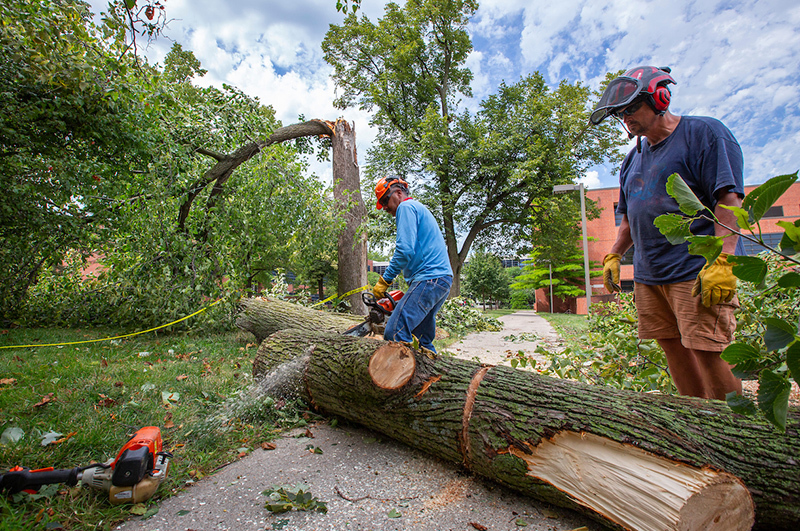
Photos by Christopher Gannon.
Groundskeeper Efrain Ramirez (left) and arborist Brad Spainhower of campus services work to clear several downed trees south of Agronomy Hall along Farm House Lane after Monday's derecho, which packed winds of around 80 mph.
Campus services manager Barb Steiner said most campus services employees are reassigned to storm cleanup this week, with groundskeepers and equipment operators helping with pruning, raking, chipping and hauling trunk pieces. That frees up the team's tree specialists to work on tree removals and significant pruning.
Steiner said at least 42 campus trees have been or will be removed due to extensive damage. Another 100-plus need pruning -- anything from a few branches to 25% of the tree's volume. The removals range from older trees like the Norway spruce southwest of the Gerdin Business Building and a central campus sugar maple, to younger trees with oddly snapped-off tops.
She said crews still are discovering some of the less-obvious vegetation damage in the process of cleaning up the obvious. The goal, she said, is to have storm debris cleared away by Monday when classes start. Tree work will continue for several weeks.
Pictured below is the storm damage Monday afternoon on the south side of the Farm House Museum north of Ross Hall.
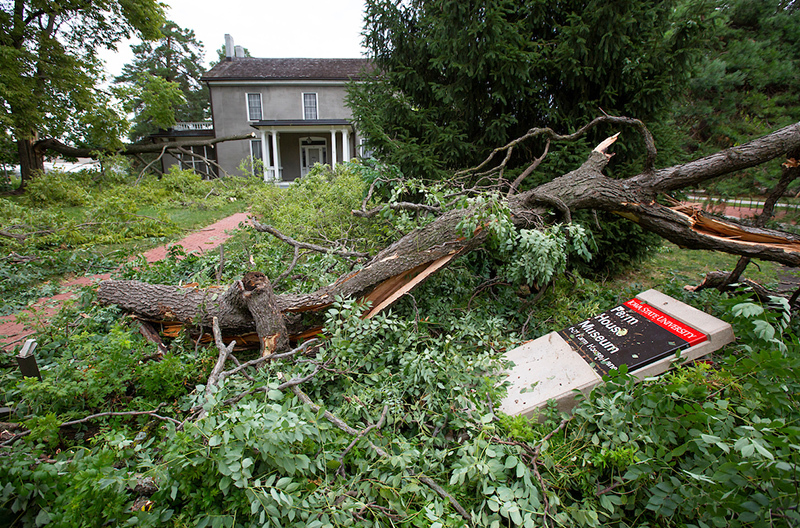
In-person instruction returns Aug. 17
For the first time since Iowa State began virtual instruction March 23, some faculty and students will be back in the classroom to resume in-person instruction during the fall semester. The first day of fall classes is Aug. 17, with a combination of in-person and online classes in response to the coronavirus pandemic.
The university has implemented numerous policies and procedures to help protect faculty, staff and students on campus. The Cyclones Care campaign focuses on four keys: Wear a face covering, practice physical distancing, wash your hands often and stay home when sick.
Here are six things to remember as in-person classes resume:
-
Face coverings are a requirement. A policy revision announced by President Wendy Wintersteen in an Aug. 5 message said cloth face coverings must be worn in university buildings at all times and outdoors on campus when social distancing is not possible.
-
It will be a first day unlike most before it with faculty advised to spend much of the first class discussing protocols and answering student questions. It is recommended instructors visit their classrooms before the first day to familiarize with the seating arrangement, signage, doors and technology.
-
A seating chart is key, not only to promote physical distancing, but to aid in contact tracing should any student, faculty or staff member become sick. Classroom seating charts are available online.
-
Food and drink are not recommended in learning spaces this fall, but instructors are asked to use their best judgment when establishing rules for their classes.
-
To assist students who may deal with COVID-related symptoms, faculty have been asked to structure courses to accommodate absences. This includes providing numerous assignments to choose from, online meetings to complete labs or studios, and using different methods like open-book or online exams.
-
Fall will be a time of learning and adjusting for faculty, staff and students as many classes take on a hybrid approach.
P&S Council offers formal support to budget-cutting plans
The Professional and Scientific Council passed a motion at its Aug. 6 meeting in support of the university's temporary budget-cutting plans.
The motion, enacted immediately by waiving the requirement for a second reading, acknowledged the budget crunch caused by projected enrollment losses, reduced state funding and costs related to the COVID-19 response. In response, the current fiscal year 2021 budget was reduced 5%, and FY2022 will bring another 5% reduction. To help balance the budget, the retirement match for TIAA will be reduced by two percentage points for 10 months, beginning Sept. 1. Renovations and capital projects have been frozen, and filling a vacant position requires approval from a senior vice president. Also, a retirement incentive program has been established, and the tuition reimbursement program for staff has been pared back to allow only Iowa State courses.
Additional measures may be needed. Options include a review of benefit costs such as ISU Plan health insurance premiums, which have not increased for six years, President Wendy Wintersteen said in a July 10 message to faculty and staff. To represent the interests of P&S staff, the council hopes to be involved in decisions about future budget-cutting measures.
Representing P&S staff in discussions about upcoming cost-reduction plans also is one of the four strategic initiatives the council is considering adopting for 2020-21. The other three are:
-
Advocating for solutions that address P&S staff concerns related to the COVID-19 pandemic, including flexible work arrangements and parking agreements, accessible resources and mental health support
-
Calling for meaningful training for supervisors with a focus on the fundamentals
-
Recommending communication surrounding the final phase of the classification and compensation review, with particular attention to employee rights, working titles, compensation structure, market equity and understanding career progression options.
The council will vote on the strategic initiatives at its September meeting.
Child care uncertainty
Cris Broshar, worklife specialist with university human resources (UHR), gave a presentation on UHR's child care and family services, in light of the uncertainty surrounding child care and K-12 schools during the pandemic.
"We understand the constant changes and unpredictable circumstances are taking a toll," she said.
UHR currently is conducting a survey of ISU employees with children in kindergarten through sixth grade to determine their child care needs in the coming school year. If a need is identified, the university may consider facilitating additional child care options, services that would be paid for by the families of enrolled children. Parents who didn't receive the survey can request a link by emailing ccfamily@iastate.edu. Survey responses are due by 4 p.m. Aug. 14.
Vice president of extension and outreach John Lawrence, chair of the executive fall planning committee, said there has been discussion about using classrooms currently unoccupied due to capacity limitations if space is needed on campus for third-party child care services.
Response team hotline connects employees to COVID-19 answers 24/7
Even after an unprecedented planning effort, many questions are bound to emerge this fall. Some will be predictable. Some won't. The COVID-19 response team that launched this week will give faculty and staff an easy way to quickly get assistance with common issues and, when the unanticipated comes up, connect with university leaders to seek answers.
"We know there will be unanswered questions we haven't considered," said study abroad center director and C.G. "Turk" and Joyce A. Therkildsen Professor of Industrial and Manufacturing Systems Engineering Frank Peters, who is leading the response team effort.
How to get help
Faculty and staff can call the COVID-19 response team helpline 24/7 at 800-447-1985 to request assistance, report a problem or share a solution. Team members and other details are available on the response team webpage.
Employees can reach the response team 24 hours a day by calling the Iowa Concern hotline at 800-447-1985. Operators will have information, provided by the response teams, for addressing common concerns such as needing more Cyclones Care signs or enforcing the face coverings policy.
In some cases, calls will be routed to the response teams in each college and academic affairs unit. College-level representatives have a good handle on local operations, needs and priorities, Peters said. Colleagues also can contact the college-level response team leads directly instead of through the hotline.
Some questions will require a university-level response and will be taken up by the university response team, which includes experts in health, logistics, legal, information technology, communications, human resources and other fields as well as representatives from each college, extension, library and research. The university response team will identify frequently asked questions that call out for communication, whether across campus or for specific groups. For some problems, it will need to develop solutions and best practices.
The response team will meet daily, and Peters -- along with vice president for extension and outreach John Lawrence, a response team member and chair of the executive fall planning committee -- will be in daily senior leadership meetings and emergency operations center meetings. Tracking the inquiries submitted to the response team will give leaders a way to hear direct feedback from faculty and staff, who in turn have a conduit to decision-makers.
"Essentially, this is a phone number you can call and be one step away from senior leadership," Peters said.
The response team doesn't supplant existing 24/7 phone numbers for university services such as IT (294-4000), facilities planning and management (294-5100) or public safety (294-4428).
For more information about the response team, including a list of university-level and college-level representatives, check out the response team webpage.
Service where you are
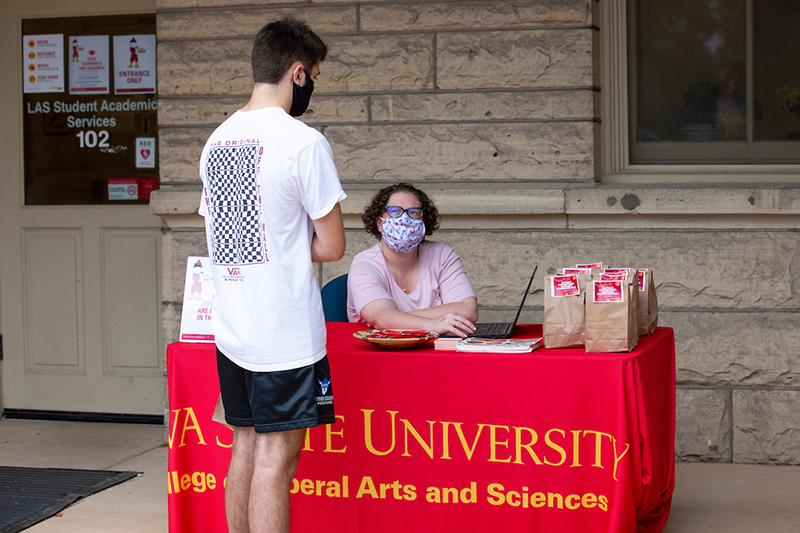
Photo by Christopher Gannon.
Academic adviser Emily Olson, College of Liberal Arts and Sciences, assists freshman journalism student Logan Shanks outside Catt Hall Monday morning. Olson proposed the idea of an outdoor advising station during student move-in and her colleagues in LAS student services embraced it as a means to provide prompt, top-notch service while also keeping employees, students and family members safe.
So far, about five students or parents stop by each day with questions about everything from course delivery methods to best places to eat -- though the pace is picking up. Director of LAS student services Jennifer Owens said the plan is to continue the walk-up advising table as long into the fall as the weather allows. The goal remains face-to-face interactions with the students they advise, she said.
Instructor creativity improves virtual learning this fall
When fall classes begin Aug. 17, virtual instruction will not be the same as what students experienced during the spring semester. Faculty and staff have taken strides to provide students with more interaction and support -- hallmarks of an Iowa State education.
"I hope they notice three things," director for academic quality and undergraduate education Shawn Boyne said. "Their instructors are all using Canvas, and using it more effectively. The learning is more interesting. Finally, they will have seamless interaction with the people they need to meet to get academic support on campus."
Guidelines drafted for summer courses increased the minimum amount of active faculty-student interaction, and those have been updated for fall.
The Center for Excellence in Learning and Teaching (CELT) worked with the provost's office to provide faculty with ways to design courses and engage students in the online environment. CELT has conducted nearly 400 departmental trainings since May 8 in preparation for the new academic year, Boyne said.
Student support
Course design and engagement are two key areas emphasized for the fall term, with significant resources also added for academic support. EAB Navigate allows students to easily schedule a virtual appointment with their adviser. Students access it through the "Student" tab in AccessPlus, while faculty and staff can find it in Okta.
"If an adviser's office is not large enough to provide the adequate physical distancing, the students or faculty can request a virtual appointment," Boyne said.
The Academic Success Center also will offer supplemental instruction and small group tutoring in a synchronous online format.
Inside caught up with a few faculty who found ways to bolster their students' fall experiences.
A new way to travel to Central America
Lee Burras, Morrill Professor in agronomy, prefers to teach with a whiteboard and marker. It’s the best way to get discussion going, and students favor his style to PowerPoint presentations, he’s found. When the coronavirus put the kibosh on two study-abroad trips, this old-school teacher thought outside-the-box to provide his students a unique opportunity.
Burras views travel and learning directly from those living in other countries as key to the Iowa State experience, sending him to Costa Rica 18 times and Uruguay three times. With trips not possible this fall, Burras is bringing experts to his two study abroad programs.
"We need to offer something now more than ever," said Burras. "The last thing I want is for Iowa State students to miss the opportunity to have meaningful experiences internationally."
Burras built a Canvas course that allows his hosts in the two countries to record themselves experiencing many of the things students would do. They will be delivered asynchronously 10 times during the semester to give students the chance to discuss a variety of topics.
Burras also has a synchronous element where his hosts -- a coffee farmer in Costa Rica and a professor in Uruguay -- will talk to the classes once a week.
Back in the lab
Getting students into the lab is one of the biggest goals of the fall semester, and something assistant teaching professor in genetics, development and cell biology Carly Manz helped work on this summer. Manz will teach hybrid anatomy and biology labs this fall.
Last spring, the biology lab moved lecture videos and assignments online, but dissections were not possible. Constructing a safer lab space brought together instructors from biology, chemistry, physics and geology to share ideas and get feedback from environmental health and safety staff.
"We really want to prioritize students being able to do dissections," Manz said. "We will have half the class at a time meeting in-person in the lab rooms and getting those experiences."
Safety of students and instructors is key. Customized plexiglass barriers were ordered with slots for a dissection tray. This allows two students -- one on each side of a barrier -- to work together.
"We hear from students that labs are where they learn the most," Manz said. "To be able to do things hands-on and see things in three dimensions is where they really cement their learning."
Walk this way
Associate professor of regional planning Carlton Basmajian is moving the History of City Planning in the U.S. online for the first time. He has recorded lectures for his class of more than 100 undergraduate students, but he wanted to apply what they are learning in the course to Ames.
"I want to make this as rich of an online experience as I can," Basmajian said. "I am recording a series of walking tours of Ames. I am using the physical infrastructure of Ames as a way to show locally the same concepts I talk about in the lecture."
He discusses the history of the places around the city, connecting significant themes from lectures.
Basmajian is shooting the video and editing it into shorter clips to replace the walking tours he used to do with his in-person class a couple of times a semester.
Timing is everything
Last fall, assistant professor in plant pathology and microbiology Nancy Boury developed and taught a course based on predicting the next epidemic. The class -- taught during the second half of the first semester -- is delivered online, but Boury is taking advantage of teaching a subject happening in real time.
"We talk about the generalities, but we apply it to this very specific example of COVID-19," she said.
Boury uses the Studio app in Canvas to embed questions throughout her recorded lectures to make sure students are following the information. She also utilizes the Packback discussion platform to create more interaction in the virtual environment. Boury plans to put students into groups in her online classes to promote discussion and provide a sense of community.
"That will be key in my first-year classes because I want them to get that personal interaction with their peers," she said. "That is one of the more distancing things of online learning. It is about those social connections and engaging with each other."
Instruction with a little grace
The coronavirus has provided unexpected obstacles, but Amy Kaleita is trying to determine the best way to remotely assist her students while receiving chemotherapy treatment for cancer.
"I have stuff going on in my life, no doubt there are students dealing with stuff going on in their lives, so we are all going to have to operate this semester -- and every semester -- with a little grace," the agricultural and biosystems engineering professor said.
Last spring, Kaleita taught a computer programming and problem-solving course for engineering students utilizing a hybrid model with lecture videos. But she missed the community when the class met in the computer lab, allowing her to communicate directly and answer questions immediately.
Kaleita began using Webex Training -- which provides features like polling, breakout rooms and collaborative whiteboarding -- to regain some connection, and she continues to look for more touch points.
Search resumes for vice president for research
The search for Iowa State's next vice president for research will resume this month with visits from two remaining finalists.
Shashank Priya, associate vice president for research at Pennsylvania State University, University Park, and the first finalist, completed his campus interview in March before the search was paused due to COVID-19. The second finalist will visit campus Aug. 24-25; the third will visit campus Sept. 1-2.
The candidates will be announced one business day before their visits. They will meet with faculty, students and staff in a mix of virtual, hybrid and in-person sessions to best meet the goals of safety and interaction between the candidates and the campus community.
Information on finalists' virtual open forums will be announced in the coming weeks. The forums will be recorded for those unable to attend at the original time, and posted online once all of the finalist visits are completed.
As they become available, details will be posted to the Provost's Office search page, including finalists' curriculum vitae and interview itineraries.
Signs of care everywhere
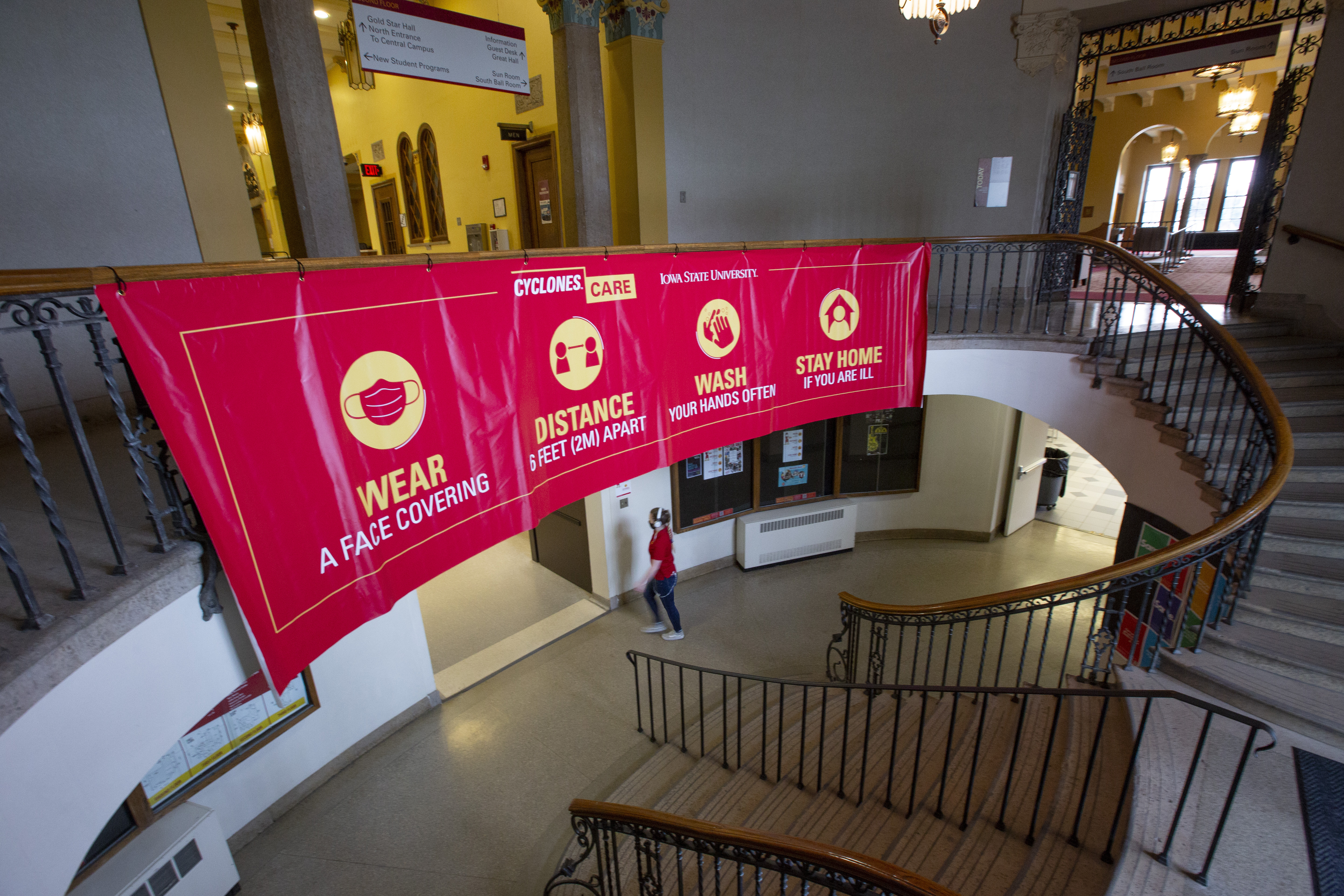
A Cyclones Care sign hangs in the Memorial Union. Photos by Christopher Gannon.
It might a surprising sight for anyone back on campus next week for the first time since spring. At every turn, there's a reminder of how Cyclones can help make the return to in-person instruction successful. The Cyclones Care campaign provides coordinated behavior messaging centered around four key behaviors: wearing a face covering, staying 6 feet from others, washing hands and staying home when ill. The city of Ames and Story County are partners in the campaign. You can be, too. For PDF and social media downloads, videos, email signatures, style guides and links to ordering signs from printing services, check out the Cyclones Care website.
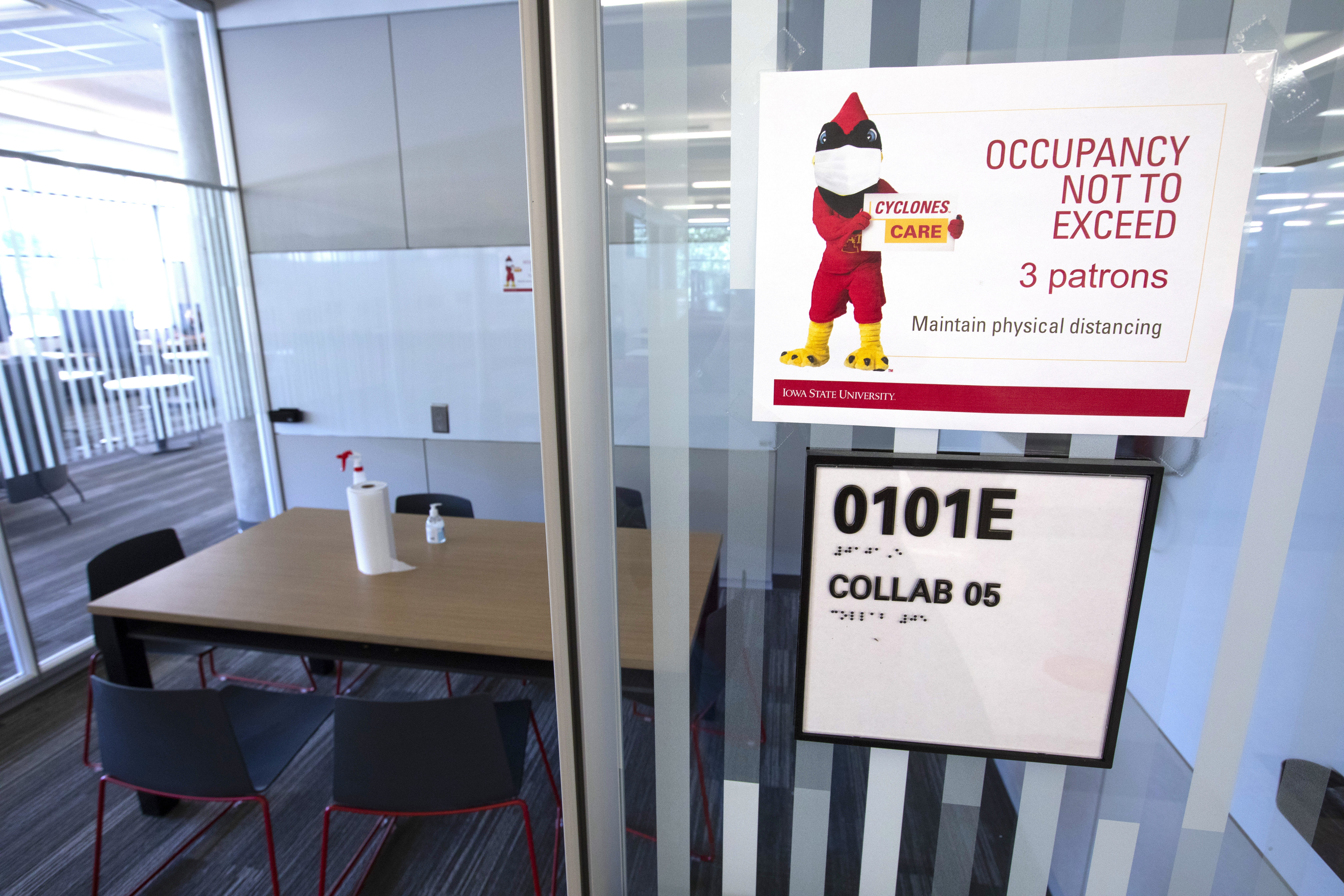
A sign notes the reduced capacity in a collaborative room in Parks Library.
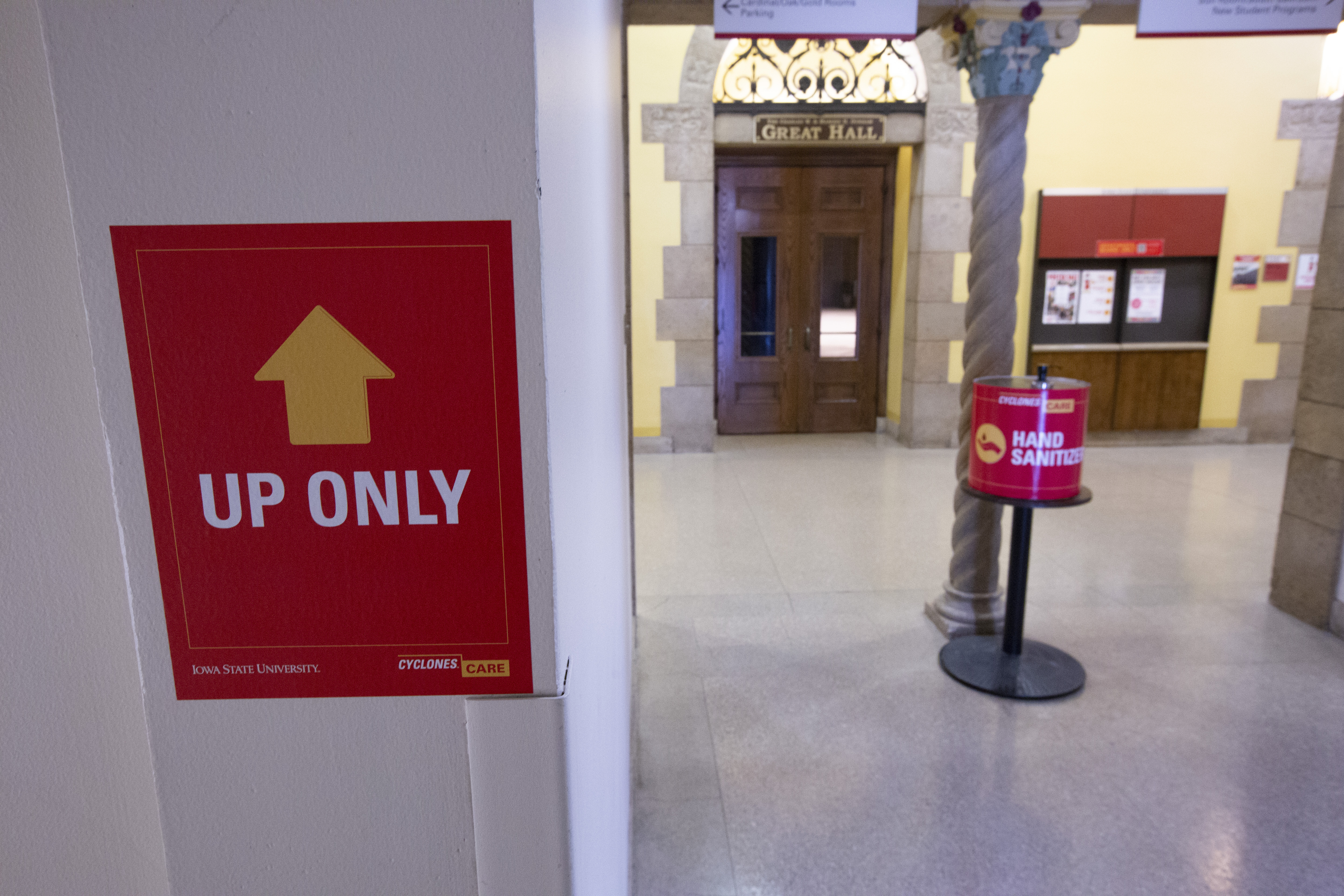
Signs establish that it's one-way traffic on Memorial Union staircases.
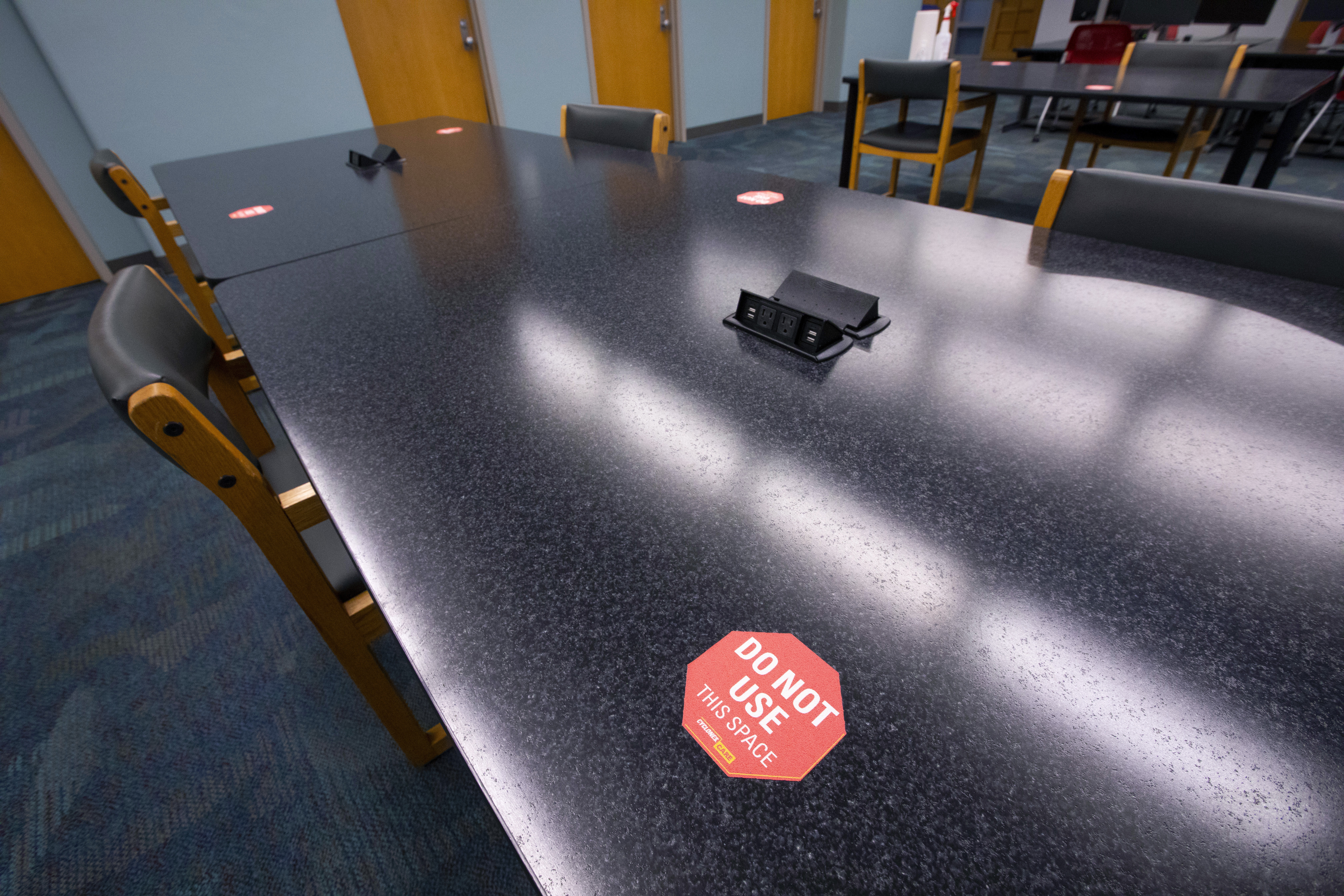
In classrooms and other spaces across campus, some seats have to be marked off-use to allow for distancing.
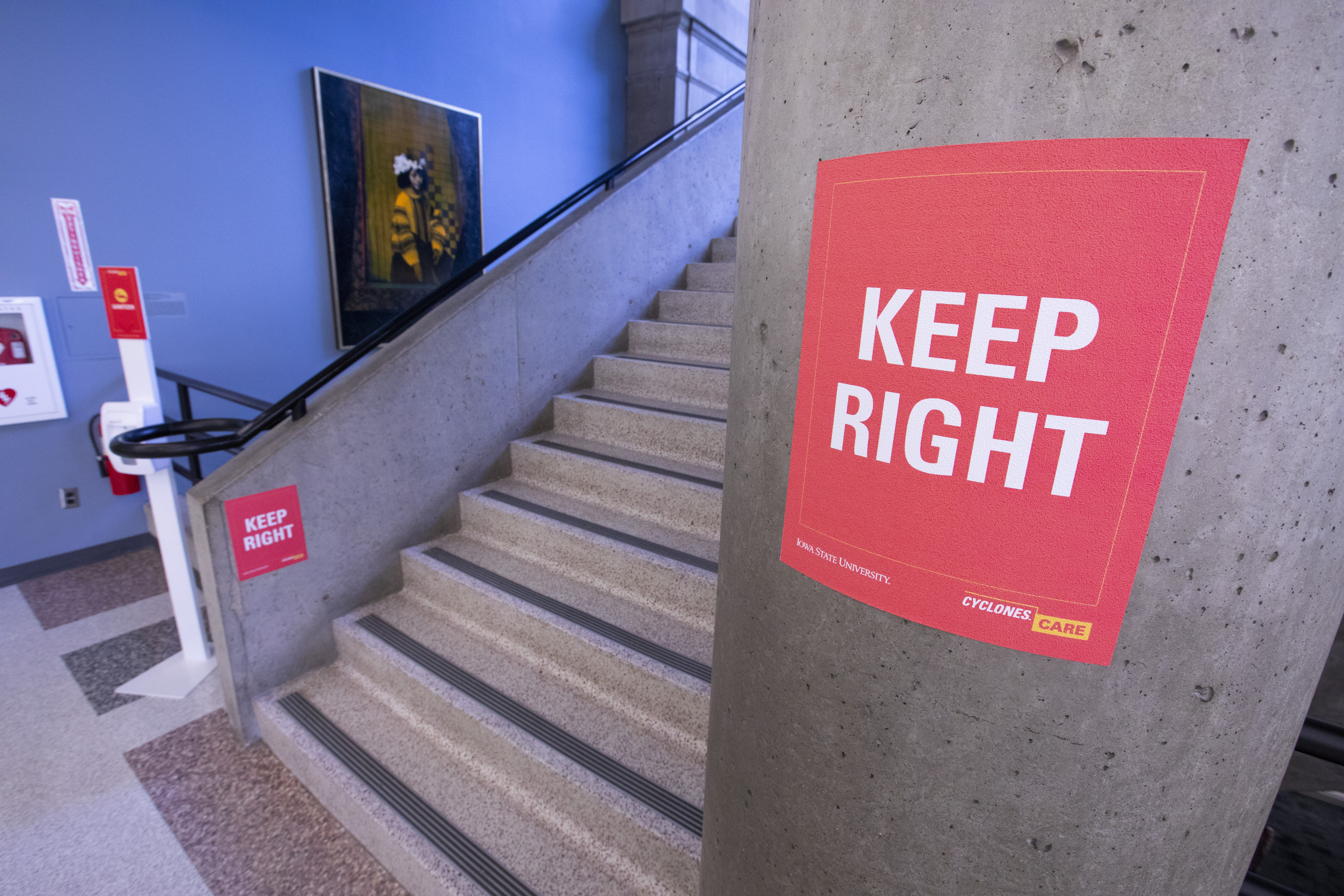
A Cyclones Care sign directs traffic on a Parks Library staircase.
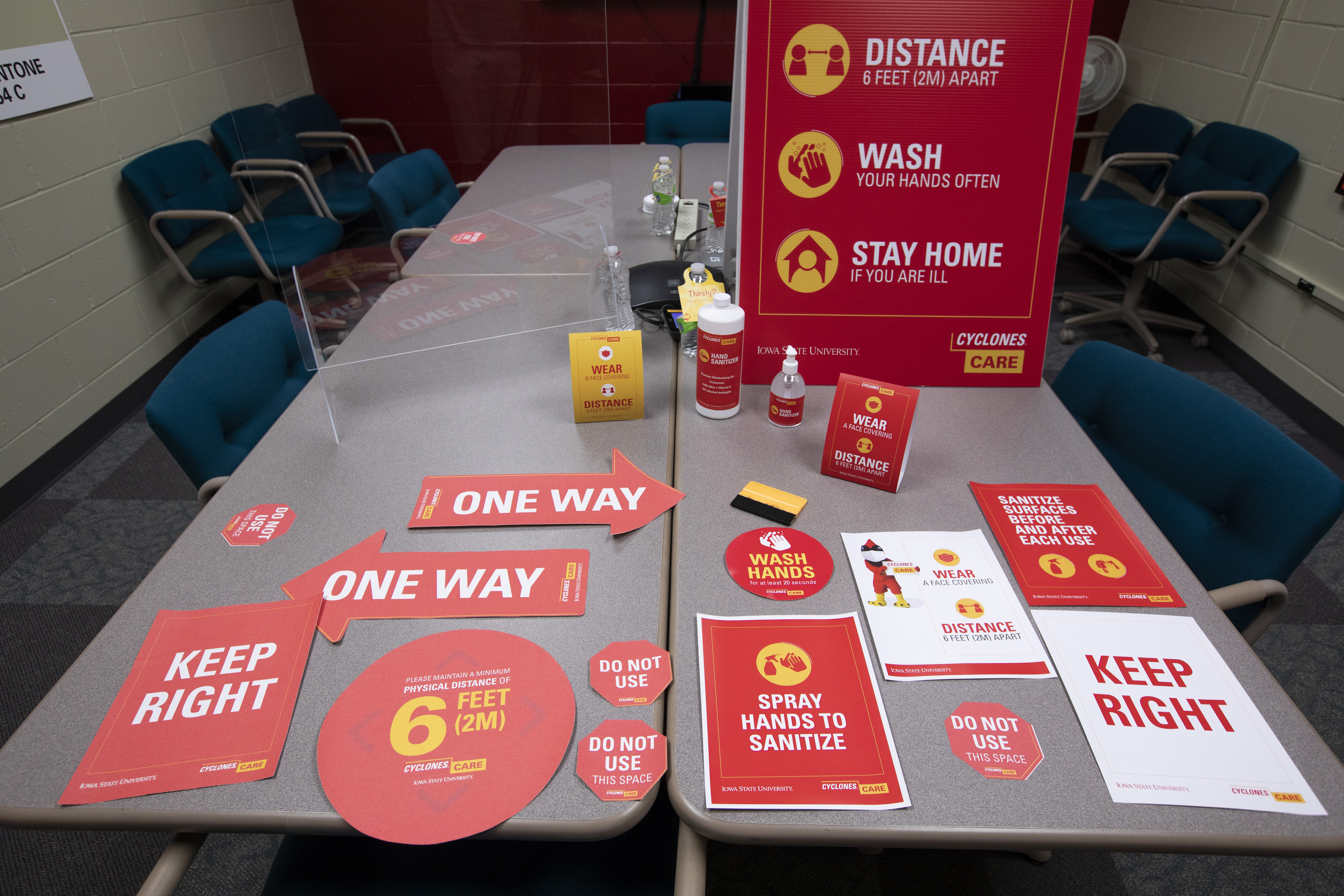
ISU printing services has produced a wide variety of signs and decals for the Cyclones Care campaign.
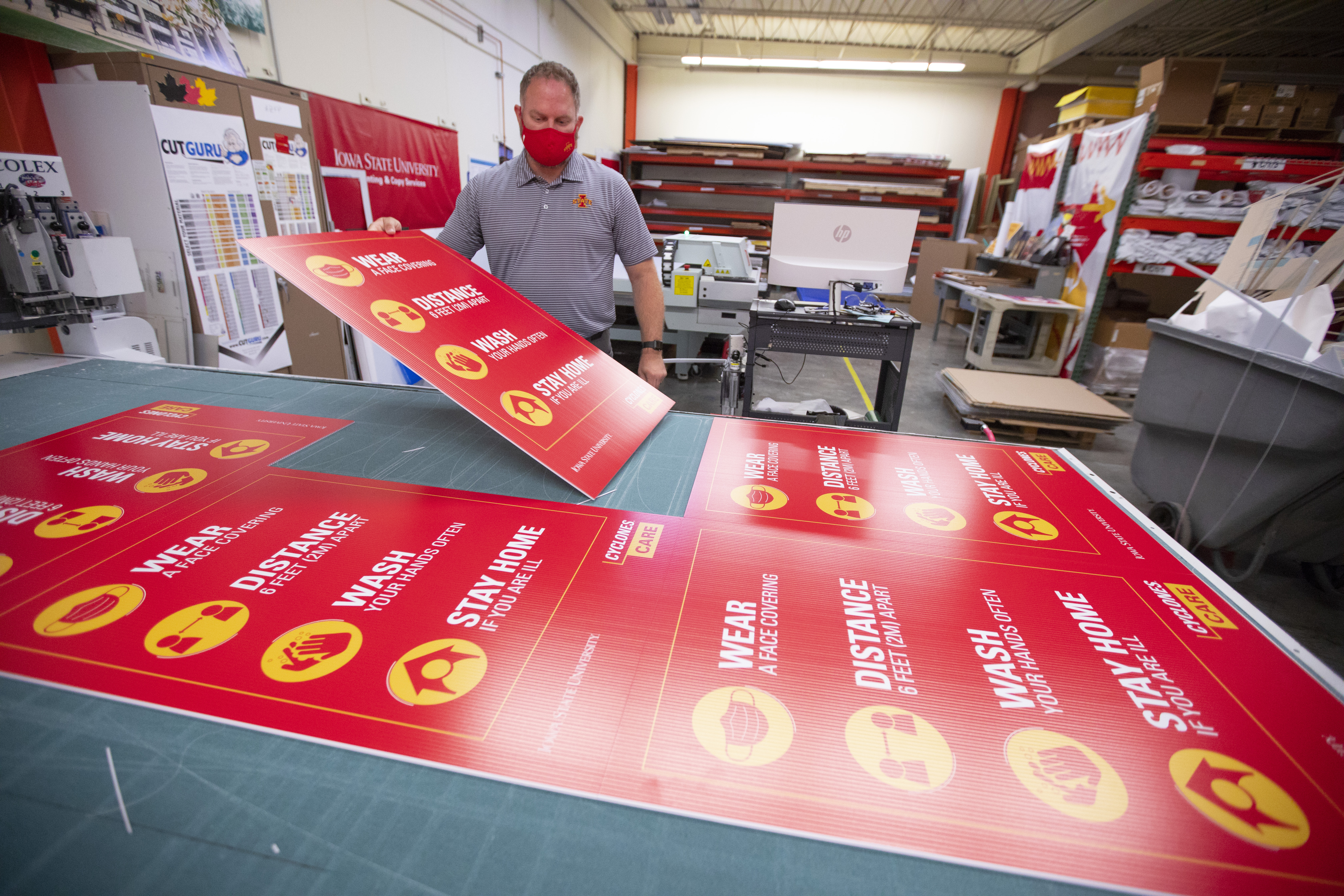
ISU printing services director Nathan Thole lifts one of many signs cut to size on a large flatbed cutter.
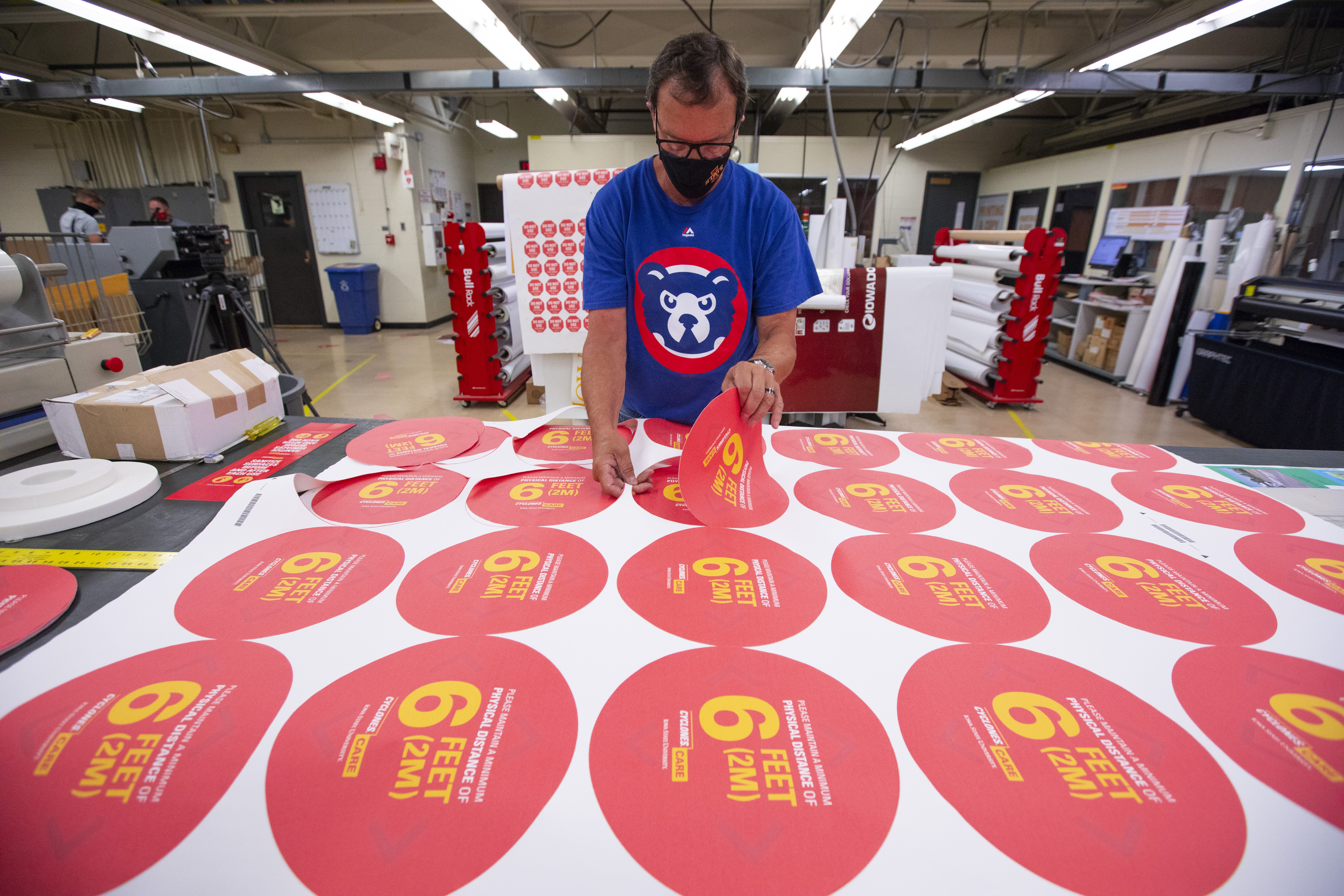
Steve Miller of ISU printing services peels floor decals from a large sheet of printouts.
Navigating lunch with a face covering
Face coverings and lunch don't mix well, right? The university's updated face covering policy, as reported last week, clarifies that faculty, staff and students must wear them indoors, with just a handful of exceptions. One of those is while eating or drinking. But even then, Iowa Staters need to be cautious.
Employee lunch room
As part of local return-to-campus workplans completed this summer, units had to revise the capacity of their conference rooms and break rooms to respect 6-feet physical distance requirements -- and post those new capacities. Employees removing their face coverings to eat lunch in a designated break room or dining area should spread out, staggering lunch periods if needed to maintain distance and keep everyone safe. If office layouts don't allow employees to work at least six feet from each other, the practice of eating lunch at your desk should be abandoned for now.
Snacking at your desk
When coworkers are present, employees should minimize consuming food and drinks at their workstations. Faculty and staff should lower their face covering only for the time necessary to take a drink and promptly replace the face covering. Likewise, an afternoon popcorn snack shouldn't become an excuse to remove a face covering for 15 minutes while working at your desk. Instead, take it to a designated break area.
Remember to wear outdoors, too
The updated face covering policy notes they should be worn "on university property," including outdoors when others are -- or may be -- present and 6-foot distancing isn't a guarantee. Employees should remember to wear face coverings in parking lots, on sidewalks, at bus stops and on lawn areas where others might gather.
CARES funding will support humanities faculty, online course development
Iowa State has received a $290,000 grant from the National Endowment for the Humanities (NEH) to support nine term faculty in the departments of English, history, and world languages and cultures (WLC). The funding will provide support for continuing instruction, as well as the development of online course materials during fall semester.
Iowa State's project, "Safeguarding Strategic Programs and At-Risk Faculty in the Humanities," was one of 317 recently announced by the NEH to support essential operations at cultural institutions across the nation. It was selected from among more than 2,300 applications. The project is being funded through the federal Coronavirus Aid, Relief and Economic Security (CARES) Act. Additional information about the NEH CARES grant program is online.
Faculty receiving support through the grant will pilot innovative online materials in a variety of subject areas, including 14 courses in Arabic, Chinese, Italian and Russian language; literature; technical communication and history. The funding supports Iowa State's ongoing efforts to integrate the humanities into the undergraduate curriculum as an essential component in meeting the global challenges facing humanity.
The project co-directors, Chad Gasta, professor and chair of WLC; Simon Cordery, professor and chair of history; and Matt Sivils, professor and associate chair of English; have worked together with the goal of shielding humanities programs and term faculty from the immediate impact of potential cuts related to COVID-19, while strengthening these programs by developing course materials that are accessible online to a broader and more diverse audience.
"The grant is a great opportunity to showcase the work of our term faculty and the critical role they play in Iowa State's academic experience," said Dawn Bratsch-Prince, associate provost for faculty and principal investigator on the award. "The university is committed to offering the highest levels of quality, both for in-class and online instruction, and I very much appreciate how these colleagues are rising to the challenges created by COVID-19."
The National Endowment for the Humanities supports research and learning in history, literature, philosophy and other areas of the humanities by funding peer-reviewed proposals from around the nation.
